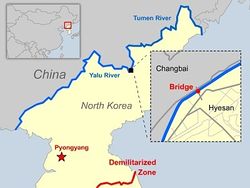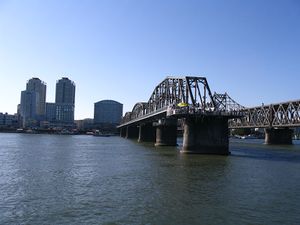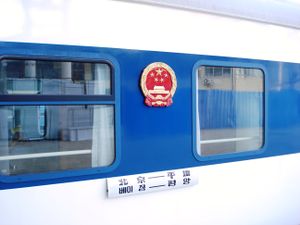حدود الصين-كوريا الشمالية
 حجر منقوش يبين حدود الصين وكوريا الشمالية في جيلين | |||||||
| Chinese name | |||||||
|---|---|---|---|---|---|---|---|
| الصينية التقليدية | 中朝邊境 | ||||||
| الصينية المبسطة | 中朝边境 | ||||||
| |||||||
| Korean name | |||||||
| Chosŏn'gŭl | 조선민주주의인민공화국-중화인민공화국 국경 | ||||||
| هانچا | 朝鮮民主主義人民共和國·中華人民共和國 國境 | ||||||
| الرومنة المعدلة | Joseon Minjujuui Inmin Gonghwaguk – Junghwa Inmin Gonghwaguk Gukgyeong | ||||||
| مكيون-رايشاور | Chosŏn Minjujuŭi Inmin Konghwaguk – Chunghwa Inmin Konghwaguk Kukkyŏng | ||||||
حدود الصين-كوريا الشمالية هي الحدود الدولية الفاصلة بين الصين وكوريا الشمالية.
. . . . . . . . . . . . . . . . . . . . . . . . . . . . . . . . . . . . . . . . . . . . . . . . . . . . . . . . . . . . . . . . . . . . . . . . . . . . . . . . . . . . . . . . . . . . . . . . . . . . . . . . . . . . . . . . . . . . . . . . . . . . . . . . . . . . . . . . . . . . . . . . . . . . . . . . . . . . . . . . . . . . . . . .
الجغرافيا
The border is 1,420 kilometres (880 mi) long.[1] From west to east, the Yalu River,[2] Paektu Mountain, and the Tumen River divide the two countries.
داندونگ، في مقاطعة لياوننگ في الصين، على دلتا نهر ياليو، هي أكبر مدينة على الحدود.[3] On the other side of the river is the city of Sinuiju in North Pyongan Province, North Korea. The two cities are situated on the Yalu river delta at the western end of the border, near the Yellow Sea. Their waterfronts face each other and are connected by the Sino-Korean Friendship Bridge.
There are 205 islands on the Yalu. A 1962 border treaty between North Korea and China split the islands according to which ethnic group were living on each island. North Korea possesses 127 and China 78. Due to the division criteria, some islands such as Hwanggumpyong Island belong to North Korea but abut the Chinese side of the river. Both countries have navigation rights on the river, including in the delta.
The source of the Yalu is Heaven Lake on Paektu Mountain, which is considered the birthplace of the Korean and Manchu peoples. This lake is also the source of the Tumen River which forms the eastern portion of the border.
There is a significant number of ethnic Koreans living on the Chinese side of the border, particularly in the Yanbian Korean Autonomous Prefecture.
التجارة والتواصل
Its border with China has been described as North Korea's "lifeline to the outside world."[1] Much of the China-North Korea trade goes through the port of Dandong.[2]
Chinese cell phone service extends 10 km (6 mi) into Korean territory, which has led to the development of a black market for Chinese cell phones in the border regions. International calls are strictly forbidden in North Korea, and violators put themselves at considerable peril to acquire such phones.[4]
Tourists in Dandong can take speedboat rides along the North Korean side of the Yalu and up its tributaries.[5]
During Peter Hessler's visit to Dandong, he noted that a common wedding day event for many Chinese couples involve renting boats, putting life preservers on over their wedding clothes, and going to the North Korean border to have wedding photos taken.[6]
المعابر
There are rail crossings along the border at Dandong, Ji'an and Tumen.
The Sino-Korean Friendship Bridge, between Dandong in China and Sinuiju in North Korea, is the most heavily used rail connection between the two countries. Ji'an, upstream on the Yalu in Jilin Province and 400 km by rail from Siping, connects to Manpo in Chagang Province. Tumen, also in Jilin and 527 km east of Changchun is located across the Tumen River from Namyang, North Hamgyong Province.
There are four weekly trains with hard and soft sleepers from Beijing to Pyongyang, as well as a weekly carriage attached to the Vostok train from Moscow via Harbin, Shenyang and Dandong.[7]
أمن الحدود
The border between North Korea and China has been described as "porous".[1] Many North Korean defectors cross into China. The Chinese government transferred responsibility for managing the border to the army from the police in 2003.[8]
In 2006 it was reported that China had erected a 20 kilometer fence on the border near Dandong, along stretches of the Yalu River delta with lower banks and narrower width. The fence was constructed of 2.5-metre (8 ft 2 in) high, T-shaped concrete poles strung with barbed wire.[2][9]
In 2007, a U.S. official stated that China was building more "fences and installations at key border outposts".[10]
In 2007, it was reported that North Korea had started building a fence along a 10-kilometre (6.2 mi) stretch of its side of the Yalu River, and had also built a road to guard the area.[11][12]
In 2011 it was reported that China was building fences 4 metres (13 ft) high near Dandong, and that 13 kilometers of this new fencing had been built. It was also reported that China was reinforcing patrols, and that new patrol posts were being built on higher ground to give wider visibility over the area. According to a resident of the area: "It's the first time such strong border fences are being erected here. Looks like it is related to the unstable situation in North Korea." The resident also added that previously "anybody could cross if they really wanted" as the fence had only been ten feet high with no barbed wire.[13][14]
A journalist who visited Dandong in 2014 reported a low level of security.[15] In 2015, fencing was reported as the exception rather than the rule.[16] In 2015, a photojournalist who traveled along the Chinese side of the border commented that fencing was rare and that it would be easy to cross the Yalu when it was frozen. The same report noted friendly contact between people on opposite sides of the border.[17]
In 2015, a single rogue North Korean soldier killed four ethnic Korean citizens of China who lived along the border of China with North Korea.[18]
انظر أيضاً
الهامش
- ^ أ ب ت Onishi, Norimitsu. "Tension, Desperation: The China-North Korean Border." The New York Times. October 22, 2006. Retrieved on October 23, 2012.
- ^ أ ب ت Kanto, Dick K. and Mark E. Manyin. China-North Korea Relations. DIANE Publishing. December 28, 2010. 10. Retrieved from Google Books on October 23, 2012. ISBN 1437985114, 9781437985115.
- ^ Rogers, Jenny. "New group reaches out to China." Gold Coast Bulletin. October 2, 2012. Retrieved on October 23, 2012.
- ^ North Korea: On the net in world's most secretive nation (BBC)
- ^ قالب:Cite new
- ^ Hessler, Peter (2006). Oracle Bones. New York et al.: Harper Perennial. p. 62.
- ^ "Trans-Siberian Railway Tours" Accessed 2014-05-25
- ^ Foley, James. “China Steps Up Security on North Korean Border”, Jane's Intelligence Review, 1 November 2003.
- ^ www.worldtribune.com "China erects massive fence on N. Korean border after test"
- ^ www.dailynk.com "China Troops Increase at North Korean Border"
- ^ www.edmontonsun.com "North Korea building fence on China border"[dead link]
- ^ "Report: N. Korea building fence to keep people in". The Houston Chronicle. Archived from the original on 1 May 2011. Retrieved 4 July 2009.
- ^ Foster, Peter and agencies, Beijing. "China builds higher fences over fears of instability in North Korea." The Daily Telegraph. March 30, 2011. Retrieved on October 26, 2012.
- ^ "China boosts North Korea border fence." The China Post. Thursday March 31, 2011. Retrieved on October 26, 2012.
- ^ Comment: The absurdities faced by North Korean refugees in China
- ^ Rob York (25 February 2015). "The myth of a sealed China-N. Korea border". NK News.
- ^ قالب:Cite new
- ^ https://www.yahoo.com/news/runaway-n-korean-soldier-kill-four-chinese-reports-060526414.html?bcmt=1420505551797-974622bd-2486-431b-8e29-2290873790fc&ref=gs https://www.yahoo.com/news/china-village-defenceless-against-north-korean-intruders-055043942.html?ref=gs
قالب:China – North Korea border crossings




